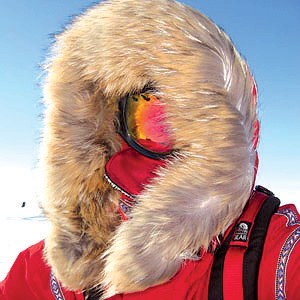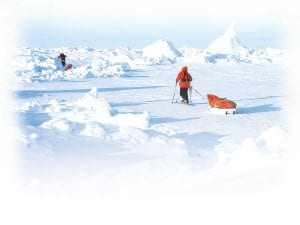Grand Marais resident Eric Larsen is concerned about global warming. That’s why he was at the North Pole on Earth Day, April 22, 2010—feeling very cold— after 51 days and 500 miles pulling a sled up and down pressure ridges and floating it across open stretches of Arctic Ocean with fellow explorers Antony Jinman (“A.J.”) of Plymouth, England and Darcy St. Laurent of Winnipeg, Manitoba.
When the expedition started at the beginning of March, the three men had less than 20 minutes of sunlight every day. When they finished, they had 24-hour sunlight. That is, when they weren’t in whiteout conditions caused by blowing snow, wet mist, and fog. “It’s my least favorite weather condition,” A.J. said one day. “It’s like being in the dark, only it’s white.”
Temperatures were often around 45 degrees below zero, rising to a high of 10 below on several days. Thelast week was “only” 25 below, but wind chills were 50 below. Sometimes they stumbled around in 30-mile-per-hour winds. They were traveling over the Arctic Ocean, which freezes, but at a colder temperature than fresh water.

Grand Marais resident Eric Larsen recently completed a journey to the North Pole, the second in a three-leg expedition to raise awareness of global climate issues and the effect of carbon emissions.
On his travel blog, Larsen described the cracking, folding, and heaving of ice sheets ramming into each other. “The noise is what surprised us the most – a long whine at one spot, the train-like chug, chug, chug’ at another, and a low pulsing in one more spot. It was eerily beautiful.”
Throughout the expedition, the team had to make up for mileage lost to the drifting of the ice. One night they drifted 2½ miles south while they slept.
Some days, progress was aggravatingly slow as they navigated over and around ice and water. After one particularly brutal section, Larsen quoted Darcy: “On a scale of 1 to 10, one being getting your tooth pulled with no painkillers, that was a minus five.”
Dealing with fear was a big part of the challenge. “We continue to take more and more risks as we travel,” Eric wrote. He talked about “rubbery” ice near sections of open water. “We got through one section, hop-scotching from one small block to the next. Thesecond we were all safely across, the ice started moving and the chunks we had just been standing on submerged.” At night, they had to be careful where they pitched their tent so it wouldn’t fall into the ocean while they slept.
Sometimes, Eric (the only one with a wetsuit that didn’t leak) had to get into the water and ferry the canoes and the other two men from one ice floe to the next. They had to watch out for polar bears and carried “bear scare flares” and shotguns. Theydid not see any bears, but they came across tracks. Larsen talked about his thoughts as he swam: “I…hoped there weren’t any polar bears nearby – they’re excellent swimmers and in my orange Gumby-like dry suit, I’m a far cry from Michael Phelps.
“…Psyching ourselves up and not out is key. As hard as this trip is physically, the mental aspect is probably more difficult. We deal with fear regularly, but that is definite and somewhat easy to control. More difficult is not knowing what is ahead and how it might affect our ability to reach the pole.”
“I am pleased with how our team has been working together and communicating under all this stress and fatigue,” Larsen wrote.
On another day, Larsen wrote, “We have settled into this life and routine. How do you determine what is important in life? Remove everything. Besides an extra Clif bar, there is little that I personally want—at least food-wise. Our needs are relatively simple here. Perhaps our goal should be to take some of this simplicity home with us.”
Larsen shared some of the lessons he learned along the way, such as not to put your goggles too close to the camp stove where they can melt: “You avoid mistakes with good judgment. Good judgment comes from making mistakes.”
Larsen’s North Pole expedition is the second of three expeditions he is making in a 365-day period to raise awareness of the effect of carbon emissions on climate: one to the South Pole (completed earlier this year), one to the North Pole, and one to the top of Mount Everest. He is still forming his Everest team and will be training in high-altitude conditions in Colorado this summer. When he is done, he plans to develop a documentary film, educational materials, and a multi-media lecture series and write a book.
“Achieving the North Pole on Earth Day is not only the realization of a dream but also a reinforcement of a basic philosophy,” Larsen wrote at the end of his journey. “The quality of our lives is directly linked to the air we breathe and the water we drink. At the North Pole, lines of longitude begin, grow and extend until they reach everyone on the entire planet. In spite of its remoteness, this is the one place that connects us all.
“…On this expedition, we often traveled within a narrow margin of safety. We had limited resources and had to conserve and meter food and fuel. There is no question that now, the 21st century, we need to use resources to ensure our health and survival. But which resources we use, how we use them (and in what quantities) and if they are renewable are cornerstones to preserving our planet for future generations. Ultimately, when we view ourselves part of a whole, we can begin to understand how our actions affect other people and the planet.
“After all, we are all explorers in one fashion or another, but the job of explorers in the 21st century is not to conquer but to protect.”



Loading Comments